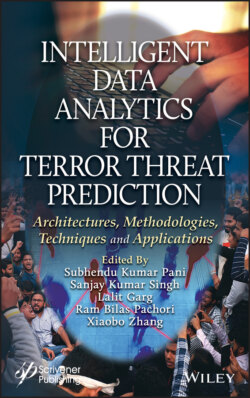Читать книгу Intelligent Data Analytics for Terror Threat Prediction - Группа авторов - Страница 2
Table of Contents
Оглавление1 Cover
2 Title Page
3 Copyright
4 Preface
5 1 Rumor Detection and Tracing its Source to Prevent Cyber-Crimes on Social Media 1.1 Introduction 1.2 Social Networks 1.3 What Is Cyber-Crime? 1.4 Rumor Detection 1.5 Factors to Detect Rumor Source 1.6 Source Detection in Network 1.7 Conclusion References
6 2 Internet of Things (IoT) and Machine to Machine (M2M) Communication Techniques for Cyber Crime Prediction 2.1 Introduction 2.2 Advancement of Internet 2.3 Internet of Things (IoT) and Machine to Machine (M2M) Communication 2.4 A Definition of Security Frameworks 2.5 M2M Devices and Smartphone Technology 2.6 Explicit Hazards to M2M Devices Declared by Smartphone Challenges 2.7 Security and Privacy Issues in IoT 2.8 Protection in Machine to Machine Communication 2.9 Use Cases for M2M Portability 2.10 Conclusion References
7 3 Crime Predictive Model Using Big Data Analytics 3.1 Introduction 3.2 Crime Data Mining 3.3 Visual Data Analysis 3.4 Technological Analysis 3.5 Big Data Framework 3.6 Architecture for Crime Technical Model 3.7 Challenges 3.8 Conclusions References
8 4 The Role of Remote Sensing and GIS in Military Strategy to Prevent Terror Attacks 4.1 Introduction 4.2 Database and Methods 4.3 Discussion and Analysis 4.4 Role of Remote Sensing and GIS 4.5 Cartographic Model 4.6 Mapping Techniques Used for Defense Purposes 4.7 Naval Operations 4.8 Future Sphere of GIS in Military Science 4.9 Terrain Evolution 4.10 Conclusion References
9 5 Text Mining for Secure Cyber Space 5.1 Introduction 5.2 Literature Review 5.3 Latent Semantic Analysis 5.4 Proposed Work 5.5 Detailed Work Flow of Proposed Approach 5.6 Results and Discussion 5.7 Conclusion References
10 6 Analyses on Artificial Intelligence Framework to Detect Crime Pattern 6.1 Introduction 6.2 Related Works 6.3 Proposed Clustering for Detecting Crimes 6.4 Performance Evaluation 6.5 Conclusions References
11 7 A Biometric Technology-Based Framework for Tackling and Preventing Crimes 7.1 Introduction 7.2 Biometrics 7.3 Surveillance Systems (CCTV) 7.4 Legality to Surveillance and Biometrics vs. Privacy and Human Rights 7.5 Proposed Work (Biometric-Based CCTV System) 7.6 Conclusion References
12 8 Rule-Based Approach for Botnet Behavior Analysis 8.1 Introduction 8.2 State-of-the-Art 8.3 Bots and Botnets 8.4 Methodology 8.5 Results and Analysis 8.6 Conclusion and Future Scope References
13 9 Securing Biometric Framework with Cryptanalysis 9.1 Introduction 9.2 Basics of Biometric Systems 9.3 Biometric Variance 9.4 Performance of Biometric System 9.5 Justification of Biometric System 9.6 Assaults on a Biometric System 9.7 Biometric Cryptanalysis: The Fuzzy Vault Scheme 9.8 Conclusion & Future Work References
14 10 The Role of Big Data Analysis in Increasing the Crime Prediction and Prevention Rates 10.1 Introduction: An Overview of Big Data and Cyber Crime 10.2 Techniques for the Analysis of BigData 10.3 Important Big Data Security Techniques 10.4 Conclusion References
15 11 Crime Pattern Detection Using Data Mining 11.1 Introduction 11.2 Related Work 11.3 Methods and Procedures 11.4 System Analysis 11.5 Analysis Model and Architectural Design 11.6 Several Criminal Analysis Methods in Use 11.7 Conclusion and Future Work References
16 12 Attacks and Security Measures in Wireless Sensor Network 12.1 Introduction 12.2 Layered Architecture of WSN 12.3 Security Threats on Different Layers in WSN 12.4 Threats Detection at Various Layers in WSN 12.5 Various Parameters for Security Data Collection in WSN 12.6 Different Security Schemes in WSN 12.7 Conclusion References
17 13 Large Sensing Data Flows Using Cryptic Techniques 13.1 Introduction 13.2 Data Flow Management 13.3 Design of Big Data Stream 13.4 Utilization of Security Methods 13.5 Analysis of Security on Attack 13.6 Artificial Intelligence Techniques for Cyber Crimes 13.7 Conclusions References
18 14 Cyber-Crime Prevention Methodology 14.1 Introduction 14.2 Credit Card Frauds and Skimming 14.3 Hacking Over Public WiFi or the MITM Attacks 14.4 SQLi Injection 14.5 Denial of Service Attack 14.6 Dark Web and Deep Web Technologies 14.7 Conclusion References
19 Index
20 End User License Agreement
